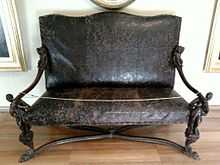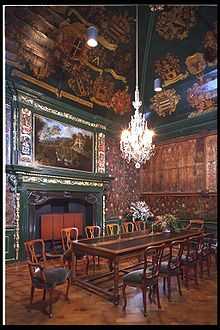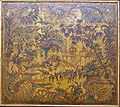Cuir de Cordoue


Cuir de Cordoue, or cordwain or cordovan (meaning: "from Córdoba"), sometimes called gold leather (from Dutch "goudleer"), refers to painted and gilded (and often embossed) leather hangings, manufactured in panels and assembled for covering walls as an alternative to tapestry.
Technique
Cuir de Cordoba is usually made of fine leather; often calf skins are used. The technique consists of shaping panels of wet leather over wooden moulds, then painting them, then oil-gilding and lacquering them. Sometimes smooth panels of painted Cuir de Cordoue were used.
Patterns for these panels followed fashions in silk damask, at some lag in time, since the high-relief wooden moulds were laborious to make. After the second half of the 18th century, this luxurious artisan product was no longer made,[1] its place taken in part by chintz hangings and printed wallpapers. In the eighteenth century Chinoiserie patterns were popular with Cuir de Cordoue.
History
Cuir de Cordoue originated from North Africa and was introduced to Spain as early as the ninth century. In Spain such embossed leather hangings were known as guadamecí, from the Libyan town of Ghadames, while cordobanes ("cordovan") signified soft goat leather.[2] In 1316, a Cuir de Cordoue guild existed in Barcelona. Spanish gold leather was popular until the early seventeenth century.
In the fifteenth or sixteenth century, the technique reached the Low Countries, first in Flanders and Brabant, where it was further developed. Though there were craftsmen in several cities (such as Antwerp, Brussels, and Ghent), the major handicraft center for gold leather was Mechelen, where it was mentioned as early as 1504. In the Dutch Republic gold leather-making flourished in the seventeenth century in Amsterdam, The Hague and Middelburg. In Amsterdam, at least eleven gold leather-makers were active. One of them, Hans le Maire, because of the smell, the need for water, wind and light, working at the edge of the city[3] or in Vreeland,[4] used up to 16,000 hides of calves and some 170,000 leaves of silver annually.[5]
Dutch Cuir de Cordoue was exported to Germany, Denmark, Sweden, China and Japan. The last Amsterdam gold leather merchant Willem van den Heuvel closed around 1680, but the trade and production continued in Flanders and Northern France.
Examples
Important examples of Cuir de Cordoue can be seen in the Netherlands in the Rijksmuseum Amsterdam, the Stedelijk Museum De Lakenhal and a side chamber of the Pieterskerk, both in Leiden, the Museum Van Gijn in Dordrecht, the Maastricht town hall and the Drents Museum in Assen. In Belgium fine examples can be seen in Museum Plantin-Moretus in Antwerp, Museum Hof van Busleyden in Mechelen and Malonne Abbey (near Namur). In Germany examples of Ledertapete can be found in the Town Hall of Bremen and Moritzburg Castle (near Dresden). In Scandinavia Cuir de Cordoue can be seen in Rosenholm Castle (Denmark) and Skokloster Castle (Sweden). Baroque State Rooms of the Wawel Castle in Kraków (Poland) were covered with an early 18th-century cordovan from king Augustus III's castle at Moritzburg.[6]
-

Hof van Busleyden , Mechelen
-
.jpg)
Town hall of Bremen
-
Antependium in the church of Alloue
See also
References
| Wikimedia Commons has media related to Cuir de Cordoue. |
- ↑ http://profkoslow.com/publications/AtlasofWorldArt.html
- ↑ John Waterer, Spanish Leather (Faber & Faber, London, 1971), outlines the history of this technique
- ↑ Abrahamse, J. E. De grote uitleg van Amsterdam: stadsontwikkeling in de zeventiende eeuw. p. 217.
- ↑ Het Goudleerhuis te Vreeland
- ↑ http://research.frick.org/montias/browserecord2.php?-action=browse&-recid=1746
- ↑ "State Rooms". www.wawel.krakow.pl. Retrieved 2013-05-13.



